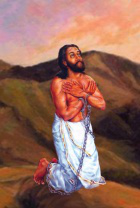India: first lay person beatified

Blessed Devasahayam Pilla
Devasahayam Pillai, a man who converted to Christianity in 18th century India and was later martyed for his faith, was beautified and declared a martyr on Sunday, 2 Decembe. The ceremony in Nagercoil, in the Roman Catholic diocese of Kottar in Southern India was presided by Angelo Cardinal Amato, Prefect of the Congregation for the Causes of Saints, acting as papal delegate. Other dignitaries present were: Salvatore Pennacchio, Apostolic Nuciature, India, four Cardinals, more than forty Archbishops and Bishops, over thousand Priests and Sisters from various places across the country witnessed the ceremony. Politicians from all parties also attended.
“It’s a great moment not only for Kottar diocese but also for the devotees, cutting across caste and religion,” said Fr Antony Gabriel, who has been heading the local committee working for the beatification process of Pillai.
Devasahayam, born Neelakanta Pillai on 23 April, 1712, an upper-caste Hindu was a member of the royal service and was close to King Marthanda Varma, then-ruler of Travancore. He converted to Christianity in 1745 under the influence of Lannoy, the commander-in-chief of the Travancore army who instructed him in the faith, and was baptized by Jesuit Fr R Bouttari Italus.
He became popularly known as Devasahayam (God’s help). Pillai’s wife, Bhargavi Ammal, also became Catholic.
“Their conversion antagonized upper-caste Hindus and King Marthanda Varma commanded Pillai to reconvert to Hinduism but he refused,” said Fr Gabriel, who has been working for the canonization of Pillai for the last 19 years.
The king ordered Pillai’s arrest in 1749, charging him with treason and espionage. Pillai was imprisoned, tortured and finally banished to the Aralvaimozhy forest, a remote border area of Travancore. According to Church documents, Pillai was beaten daily, pepper was rubbed in his wounds and nostrils, and he was exposed to the sun and given only stagnant water to drink.
Pillai was a Catholic for only seven years but his faith stands out as witness for all times to come.
“In that short period, he was in prison for three years under severe persecution for witnessing his faith. Finally, he was shot dead in the Aralvaimozhy forest on 14 January, 1752,” Fr Gabriel said.
Bishop Peter Remigius of Kottar said Pillai’s tomb at St Francis Xavier Cathedral attracts large numbers of devotees.Pillai’s life teaches “how to witness our faith,” the bishop said. “While undergoing severe persecution, he never complained or was deterred. The spirit of evangelism was strong in him.”
Source: CRIB















